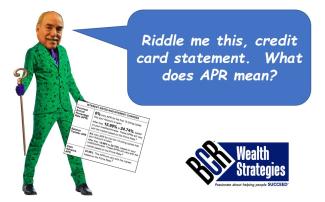
What Does APR Mean, and Why You Should Care?
If you are about to buy a house, a car, a mattress, or nearly anything on credit you are presented with an interest rate. Often adjacent to the interest rate is another rate, maybe in smaller type, designated as the APR, and that is usually higher than the interest rate in big print. What is that about? It may be a case of what the large print giveth the small print taketh away!
When borrowing money there is a charge for the use of the money until it is repaid. This charge is called interest. So, if you borrow $10,000 at an interest rate of 6% you should expect to pay $600 in interest for having the money for one year (6% of $10,000). To pay off the debt at the end of one year you should pay $10,600 and be done with the loan.
What if you are repaying the money over the course of the year? Then you do not have use of the entire $10,000 for the entire year. The monthly payment to repay this loan would be about $936.59. Your total payments would be $11,239.08. For this loan, both the interest rate and the Annual Percentage Rate (APR) are 6%.
But suppose the loan has a fee to place the loan; for a home mortgage this is often called “points” and could be 3 points. What does this mean? It means that 3% of the amount you want to borrow is added to the calculation of the loan amount before calculating the monthly payment. Therefore, the monthly payment is based on a higher amount of money than you are borrowing.
In the example above, the monthly repayment would be based on borrowing $10,300 instead of just the $10,000 you are borrowing. This would increase your monthly payment to about $964.69, and your total payments for this loan would be about $11,576.30, about $337.20 more than the no point loan. In this case, the Annual Percentage Rate is about 11.99%.
The APR tells you what interest you are paying for the amount you want to borrow for the time you actually have use of the money.
-Harold Sasnowitz

